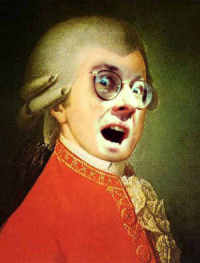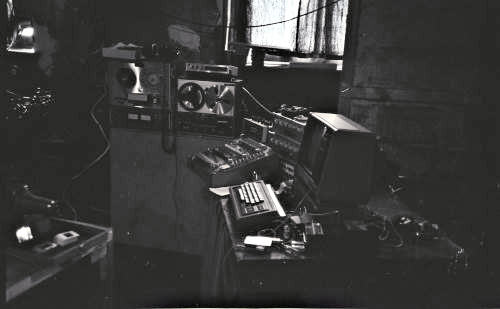A 365-Day Project
"We Are All Mozart"
A project to create
new works and change
the perception of the
music of our time.


 September 21, 2006
September 21, 2006 
Yesterday the origins of my personal musical theory were outlined. Two assumptions underpinned them that call for explanation: how people think, and how art breaks rules. Neither is intended simplistically.
No truly linear thinkers exist because we are multi-sensory beings. Though their proportions differ, each sense is relentlessly informing our physical behavior and consequently our thoughts. That coffee matters in the morning, or the light is harsh in an office, or the snack cart is coming by, or the clothing drapes comfortably, or the thermostat is too low -- all ply our thoughts into separate sheets. And the internal chatter cannot be suppressed, the flick of the taxman or spouse or child or the truck that just missed us. George Owen Squier understood it, and gave us an acoustic hook to drag the internal chorus off the mental stage. This first assumption is that the human species is always engaged in thinking in multiple dimensions, each paced uniquely, without a shared master clock. It's why time flies when you're having fun but the watched kettle never boils. Music, with its own multidimensional possibility, can engage these mental dimensions separately ... and add new levels with their own paces. It explains the tension between composers when the intellectual vs. emotional debate begins -- listeners exist in both worlds simultaneously (along with the raw sensory worlds themselves), but capitulate to the dominant reflections and desires of their experiences. Composers may hear the technical first, while lay listeners are initially overwhelmed (or cold-shouldered) by the sensory stimulation and its emotional translations. The balance of myriad factors in time and place represents how a composition is received; composers understand this, whether or not they choose to integrate it into their work. In simplest derogation, it is derided as pandering to the audience; in simplest adulation, it is praised as illuminating the human spirit. Whatever the balance, it becomes integrated in the polyglot of mind.
The second assumption, that art breaks rules, sounds like a bad-boy syndrome, the disheveled Beethoven, the ear-detaching Van Gogh, the self-destructive Cobain. Art alters some thing in a known process or object. Though the thing can be identified statistically (which is why Mozart-composing computer programs can be developed), the individual adjustments are the culturally notable aspect of that thing, and the adjustments effectively break the rules for that thing. Art is distinguished from craft in that the latter's focus is replicating the rule (or at least the last-evolved version of the rule), whereas art assumes the rule exists so it can immediately engage in the discovery and implementation of rule adjustments -- whether from boredom, deliberate vandalism, or the creation of uniqueness. Take a serial composition or a sonnet. In either a clear, overarching and rigid-seeming rule set is in place. But opportunities bulge out from the edges as each rule is adjusted finitely for near-infinite levels of uniqueness. Shakespeare alone made 154 sets of memorable adjustments. How many serial pieces Babbitt? Boulez? Wuorinen? And the adjustments take place to the rules themselves, as Schoenberg did when some reiteration of the Hauptstimme created a tonal event. Change, the manifestation of may be into is, represents art's essence.
Because these assumptions gird my composition, an aware listener is likewise assumed to share some level of experience, multidimensionality and madness. To restate, life is not divided; it consists of overlapping events that taken together constitute a personal and species evolution. It is dull to replicate this process in art, but it is thrilling to integrate these shared, redolent experiences.
Time and memory are chief among these shared experiences. Classical composers broke time into regular fragments and used restatements and repetitions and easily assessable melodic shapes to stimulate the memory. So do songwriters today. Make it simple, say it once, say it again. If filmmaking has revealed anything, however, it's that there is more to the sensory psyche than simple, linear progress and repetition. Wagner understood that, and the power of his understanding has been transmitted in sanitized form down to the contemporary soap opera and its library of musical clichés.
Which brings this discussion back to my theory of music. Once the separate streaming and overlapping character had been successful in works from Missa da Camera through Mantra Canon, the door opened to exploration of time and memory. A Time Machine (1990; alas, never performed in its three-part, 33-section entirety) had twenty-two through-composed sections, eleven song and eleven instrumental, interleaved with each other and an additional eleven "menu" sections. The songs were memorable by means of simple components and, of course, words -- which invoke a different memory mechanism -- and the instrumental interludes were self-contained and clear, with easily imprinted simplicity. [The texts were sixteen jophxo poems selected from more than a thousand generated by the computer program used in Rando's Poetic License (1978) arranged in a cycle of conception, birth, infancy, childhood, playfulness, adolescence, sensuality, maturity, security, hardening, pain, dementia, sickness, dying, death, and memorial.]
Before the composition of A Time Machine the expanding and contracting techniques had been adopted into my compositional grammar, but it was time to break my own rules (even though they had not yet been formalized or even recognized). So the music would engage the memory. Technology was incorporated, old and new: the human voice (ancient); violin, cello and clarinet (old); electronic keyboards (new via an old model); percussion (ancient); dance (ancient); costuming (new via a medieval route); video (new use via the industrial age); stage props (1940's diner design); lighting (old and new); and computer technology (new). The "time machine" reference suggests H. G. Wells's novel and the original Hollywood film that inspired in me dread and fear with its air-raid sirens. Time is past, present and future; also it is tempo, a metronome. And here is the key feature of the remaining eleven sections: they are motives extracted and distilled from the through-composed sections of A Time Machine and placed into a menu randomly generated at each performance. So either the motives will have been heard already (a reflection of the past) or are yet to be heard (a foreshadowing of the future), bringing the listener back to the past and ahead to the future of the work's internal musical timeline. Because each performance's counterpoint is unique, it compresses or stretches the whole of the apparent (emotional or perceptual) time within the work and brings unexpected meanings to the themes as they begin to appear in new guises. There are anticipatory expositions and surprising recapitulations. Each performance is fresh, unique: it has no past and no future; it has but one, present existence: the ideal of any time machine, presentness within all times.
Unfortunately, this has never been put to the test, as only the first eleven sections (Part I) have been performed. Pressing forward into time dilation and compression was Ÿçuré (1990) for two chamber orchestras with an isorhythmic underpinning, the orchestration determined by a spiral shape, the two ensembles forming an echo, and a single drum pushing its foresquare reality upon the whole ensemble. The premiere threatened to tumble into chaos, but the elements were so tightly wound and the entire piece so self-integrated that, despite no outwardly traditional clue to its shape and construction and a nearly fatal performance, the audience was compelled by it. There was much to consider in why this composition worked, particularly as isorhythm fell from the Western musical vocabulary hundreds of years ago.
It was another two years, years during which John Cage died, before the theory that had guided all this work made itself known. To say "made itself known" suggests some deus ex machina, but discovering oneself is not an obvious process, particularly if theory is only a background means to indulge in making noises. It may even seem absurd that a composer can work from unrecognized patterns for nearly twenty years. Yet sometime in 1992, after we had returned from Europe and I was archiving my disorganized mess of compositional work, the processes were revealed with great clarity.
With tongue-in-cheek formalism, I called it "Expansion-Contraction Linear Modulation."
Like Schoenberg's crystal-clear Op. 25 Suite für Klavier, a 'manifesto' composition needed to be written to demonstrate this ECLM theory in a finely distilled manner. The music should be two parts, the slenderest reed on which independent melodic motion could be revealed; it should offer memory 'stickiness' without subverting its breathing nature; it should be instantly audible for its content without being boldly obvious; it should be replicable in different ways to demonstrate its compositional flexibility; and it should be musical in a fashion that needed no theory to invite emotional response. The choice was to write seven zero-stretto canons at the same pitch class.
Seven ECLM Studies (1992), later retitled Seven Chocolate Eclems to reflect my food obsession, were precisely that -- seven miniature, simultaneous canons for violin and cello. They breathe.
Time-line epilog: A copy of the Eclems was given to composer-violinist Thomas L. Read, who enjoyed reading through my string music. But T.L. together with cellist Bonnie Thurber Klimowski surprised me with a concert performance a few months later. And, of course, once my music revealed its rules to me, it was necessary to begin breaking them.
* * *
Late addition: Tomorrow is our tenth wedding anniversary, so I'll have no commentaries until Saturday or Sunday.
* * *

Rando's Poetic License, Washington Project for the Arts, 1978, running jophxo live on the TRS-80.